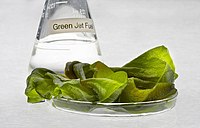
Photo from wikipedia
BACKGROUND Isochrysis sp. is a marine microalga rich in eicosapentaenoic acid (EPA) and docosahexaenoic acid (DHA). The potential use of its biomass as an alternate PUFA source has not been… Click to show full abstract
BACKGROUND Isochrysis sp. is a marine microalga rich in eicosapentaenoic acid (EPA) and docosahexaenoic acid (DHA). The potential use of its biomass as an alternate PUFA source has not been studied in animal models. Male albino Wistar rats were divided into three groups and treated for 28 days: rats fed with (1) standard chow (control group), (2) microalgal biomass rich in EPA and DHA along with standard chow (microalga group), and (3) fish oil that contains equivalent amount of EPA and DHA along with standard chow (fish oil group). After intervention, biochemical indices, histopathological indices, relative mRNA expression of PUFA genes, antioxidant genes, inflammatory markers, and the fatty acid profile of major tissues were studied. RESULTS Animals treated with microalgal biomass showed significantly increased serum HDL levels (P < 0.05) and reduced oxidative stress markers with concomitant decrease in urea and creatinine levels. Oral supplementation of microalgal biomass did not show any toxicity or damage in any major organs. The mRNA expression of PUFA genes was significantly downregulated (P < 0.05) and antioxidant genes were upregulated. Furthermore, the mRNA expression of pro-inflammatory markers was significantly downregulated (P < 0.05) and anti-inflammatory markers were upregulated. Oral supplementation of microalgal biomass improved DHA status in brain and liver. CONCLUSION The present study demonstrated that Isochrysis sp. can be used as a safe, alternate food supplement for ω-3 fatty acids. This article is protected by copyright. All rights reserved.
Journal Title: Journal of the science of food and agriculture
Year Published: 2019
Link to full text (if available)
Share on Social Media: Sign Up to like & get
recommendations!